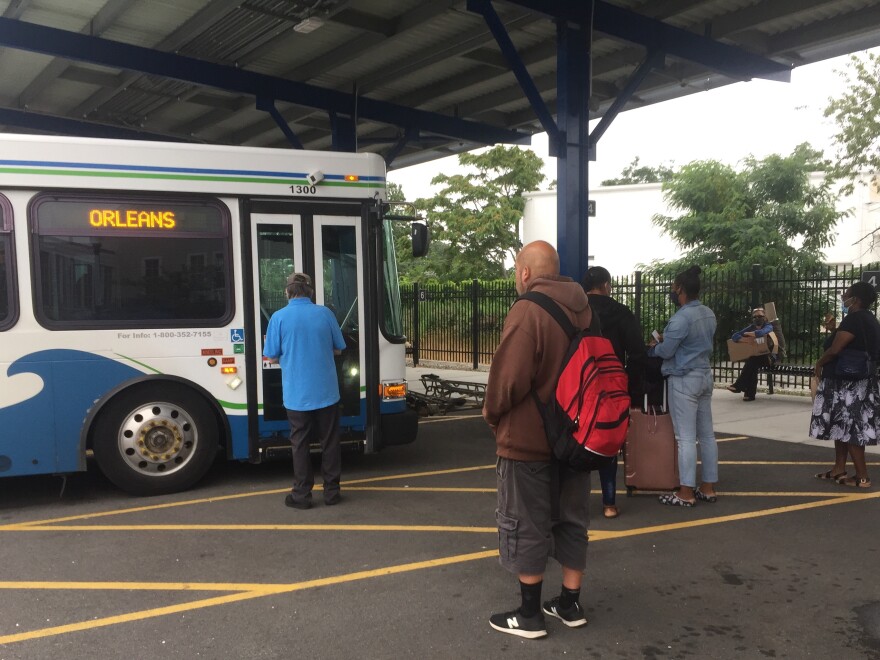This is the conclusion of a two-part story on what it’s like to depend on the Cape Cod bus system and how public transit here is changing. Listen to Part 1 here.
“Right here, you're getting off at Stone Horse?” calls driver Andrew Ianniello to one of the foreign students on the bus.
“Thank you,” the student says as he turns toward the door, “and have a good day.”
“You have a good day, sir.”
We’re in Harwich, headed east to Chatham, and then to the end of the line at Stop & Shop in Orleans.
As the crowd thins out, Ianniello gets a chance to reflect on some of what’s cool about the bus.
“We are equipped to handle all kinds of mobility devices,” he says. “And there's a fair number of people that rely on mobility devices, whether it's a traditional wheelchair or it's a rascal or…”
The list goes on. He explains how they get fastened into the bus.
Part of what stands out to him, he says, is how other riders want to help, even if it just means stepping off the bus to make room while he secures the chair.
“For the most part, everyone that rides the bus is a regular, you know?” he says. “They're a part of the family, and there's this sense of community that goes along with it. You know what I'm saying?”
“Skaket Corners!” he calls out as the bus approaches another stop.
We make it to the Orleans Stop & Shop just after 3 o’clock, an hour late.
Ianniello starts his day at 6:30 a.m. He says the first two runs are usually on time, but after that, delays start to pile up.
“There's this domino effect that occurs when the traffic gets crazy like that, and there's nothing you could do about it,” he says. “You just sort of go with the flow.”

That’s not unlike riding in a car on the Cape on a summer afternoon, said Transit Authority Administrator Tom Cahir.
“It's a constant problem and always will be on Cape Cod, where the roads were never built to accommodate the volumes of traffic that we're seeing in the summer months here,” he said.
Another bus hazard? The tight squeeze.
We have a new driver on the ride back to Hyannis from Orleans. Before the bus even makes a stop, it approaches a right turn and has to thread the needle between an oncoming bus and a car parked close to the corner.
The scrape is so slight, no one but the driver knows anything’s amiss until she pulls over in front of an art gallery down the street.
A woman from the car approaches the bus. She asks the driver to call the police.
Driver Suzanne Lincoln stays totally calm and professional.
“He’s just going to fill a report out, and [we] should be all set,” she says.
But as we wait for the police to do their work, a ride that started on time just a few minutes ago is already getting delayed. Add the traffic, and we roll into the Hyannis station at 6:19 p.m. instead of 5.
Advocates say the system would be more usable if buses came more often.
The headway — that’s the time between buses — is typically an hour on the Cape, though it was 30 minutes in some places before the pandemic reduced ridership.
John Stout, of the Massachusetts Public Interest Research Group, said buses spaced that far apart can make for some inconvenient moments.
“[If] you miss a bus that comes every half an hour, that's pretty bad news for you, and you might be late to work or some other important appointment,” he said. “So I think increasing the amount of service we have, and also the frequency of service, is really what's going to encourage more folks to get on public transit.”
And that serves other policy goals, such as reducing carbon emissions.
The big prize there is full conversion to electric buses, which his group is calling for by 2030.

Another thing missing on the Cape is Sunday service in the off-season.
Alexis Walls of the Massachusetts Public Health Association said adding more night and weekend buses is a top priority for transit advocates.
“I mean, folks have lives after 8:00 p.m., right?” she said. “It also affects employment, because we know there are a lot of jobs that require late-night or early-morning shifts.”
Expanding service would require more money — public money. Like similar transit authorities around the state, the Cape Cod Regional Transit Authority can’t support itself on fares and advertising alone, and receives millions of federal and state dollars.
But what is coming, maybe by late fall, is a way to see online when buses are actually going to arrive, said Cahir, the administrator.
That means riders like nursing assistant Angela Brown, who spends an hour getting from Dennis Port to Brewster, won’t have to guess whether the bus is late, only to just miss it.
“I was out here earlier to catch the 1 o'clock one, but when I was going, they passed, so I had to wait for this one,” she says.
So, where’s the balance between time and money, between carbon emissions and convenience? The answer may still be down the road.
And who’s on that road?
One more time, here’s driver Andrew Ianniello: “The fact of the matter is, is we move the workforce, whether it's the year-round workforce or the J1s that supplement in the summertime,” he says. “We move the people that keep the wheel rolling.”








